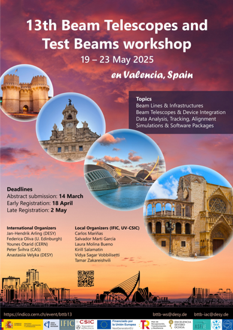Speaker
Description
The current ALICE Inner Tracking System (ITS2) is based on Monolithic Active Pixel Sensors (MAPS) called ALPIDE. During LHC Long Shutdown 3, its three innermost layers will be replaced by the ITS3 detector. It will based on wafer-scale silicon sensors of up to 26 cm $\times$ 10 cm, thinned to about 50 $\mu$m and curved into truly cylindrical detector layers. The first prototype of the sensor - MOnolithic Stitched Sensor (MOSS) - was produced in 2023. It consists of ten Repeated Sensor Units (RSU) stitched together. Each RSU consists of two half-units (HU) labeled top and bottom, with a pixel pitch of 22.5 $\mu$m and 18 $\mu$m, respectively. Each HU contains four matrices, also referred to as regions, with a pixel count of 256 $\times$ 256 and 320 $\times$ 320, respectively. To facilitate in-beam and irradiation studies, a single-RSU sensor with an area of about 30 $\times$ 14 mm$^2$, the so-called babyMOSS, was produced.
To increase the scope of the ITS3 sensor qualification, a new dedicated beam telescope was built. In contrast to the standard ITS3 telescope, which uses ALPIDE sensors, this telescope is based on babyMOSS sensors assembled in six reference planes and a device under test (DUT) plane in the middle, spaced 2.5 cm apart. This arrangement provides a tracking resolution of about 2 $\mu$m. All planes are read and controlled by ALPIDE DAQ boards adapted for use with babyMOSS using custom-designed interface boards. The trigger system consists of two scintillators of the same size as the babyMOSS, placed before and after the reference planes. With careful alignment, a trigger efficiency of about 12 $\%$ per region is achieved. Data acquisition is managed via the EUDAQ2 framework.
The babyMOSS telescope has been commissioned in the lab with cosmics. It was used in three consecutive test beams at CERN PS in 2024 with a 10 GeV pion beam and in a test beam at ELSA in Bonn in 2025 with a 2.9 GeV electron beam. A total of five DUTs were characterized in terms of detection efficiency, spatial resolution and cluster size. The results show that the current sensor prototype achieves a detection efficiency of $>99 \%$ with a fake-hit rate below the ITS3 requirement of $10^{-6}$ hits/pixel/trigger.
This contribution presents the design, implementation, and results of the babyMOSS telescope, highlighting its role in qualifying the ITS3 pixel sensors in several test beam campaigns.
